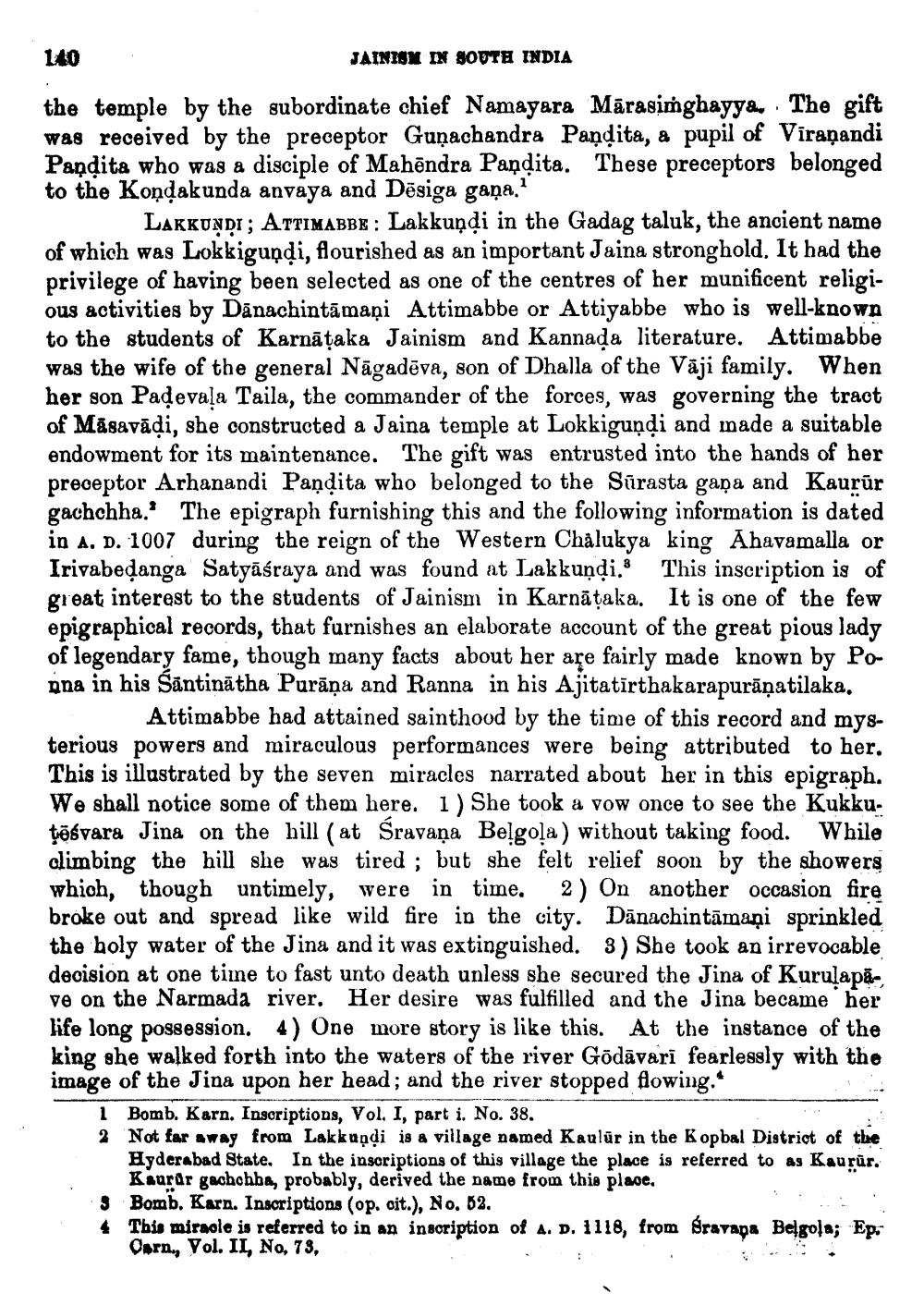________________
140
JAINION IN SOUTH INDIA the temple by the subordinate chief Namayara Mārasinghayyam. The gift was received by the preceptor Gunachandra Pandita, & pupil of Viraṇandi Pandita who was a disciple of Mahēndra Pandita. These preceptors belonged to the Kondakunda anvaya and Dēsiga gana.
LakkuŅDT; ATTIMABBE : Lakkuņdi in the Gadag taluk, the ancient name of which was Lokkigundi, flourished as an important Jaina stronghold. It had the privilege of having been selected as one of the centres of her munificent religious activities by Dānachintāmaņi Attimabbe or Attiyabbe who is well-known to the students of Karnāțaka Jainism and Kannada literature. Attimabbe was the wife of the general Nāgadēva, son of Dhalla of the Vāji family. When her son Padevala Taila, the commander of the forces, was governing the tract of Māsavādi, she constructed a Jaina temple at Lokkiguņņi and made a suitable endowment for its maintenance. The gift was entrusted into the hands of her preceptor Arhanandi Pandita who belonged to the Sūrasta gaṇa and Kaurūr gachchha.' The epigraph furnishing this and the following information is dated in A. D. 1007 during the reign of the Western Chalukya king Ahavamalla or Irivabeđanga Satyāśraya and was found at Lakkuņời. This inscription is of great interest to the
interest to the students of Jainism in Karnataka. It is one of the few epigraphical records, that furnishes an elaborate account of the great pious lady of legendary fame, though many facts about her are fairly made known by Poana in his Sāntinātha Purāņa and Ranna in his Ajitatīrthakarapurāņatilaka.
Attimabbe had attained sainthood by the time of this record and mysterious powers and miraculous performances were being attributed to her. This is illustrated by the seven miracles narrated about her in this epigraph. We shall notice some of them here. 1) She took a vow once to see the Kukkutēśvara Jina on the hill (at Sravana Belgola) without taking food. While climbing the hill she was tired; but she felt relief soon by the showers which, though untimely, were in time, 2) On another occasion fire broke out and spread like wild fire in the city. Dānachintāmaņi sprinkled the holy water of the Jina and it was extinguished. 3) She took an irrevocable decision at one time to fast unto death unless she secured the Jina of Kurulapā ve on the Narmada river. Her desire was fulfilled and the Jina became her life long possession. 4) One more story is like this. At the instance of the king she walked forth into the waters of the river Gödāvari fearlessly with the image of the Jina upon her head; and the river stopped flowing.
1 Bomb. Karn. Insoriptions, Vol. I, part i. No. 38. 2 Not far away from Lakkundi is a village named Kaulur in the Kopbal District of the
Hyderabad State. In the inscriptions of this village the place is referred to as Kaurür.
Kaurar gachohba, probably, derived the name from this place. 3 Bomb. Karn. Inscriptions (op. cit.), No. B2.
This miracle is referred to in an inscription of a. D. 1118, from Oravapa Belgola; Ep. Carn, Vol. II, No, 73,




